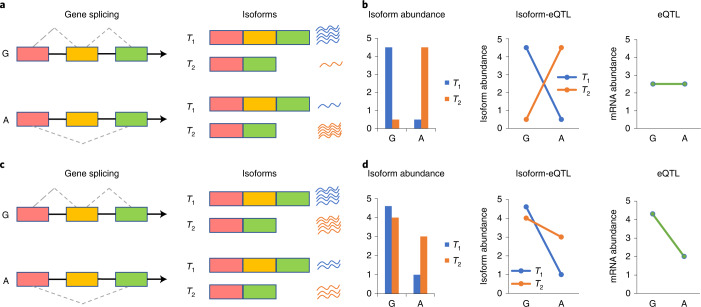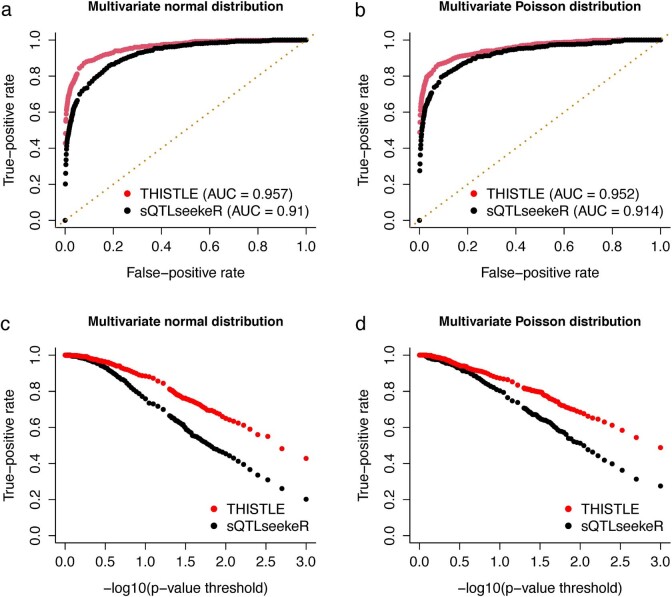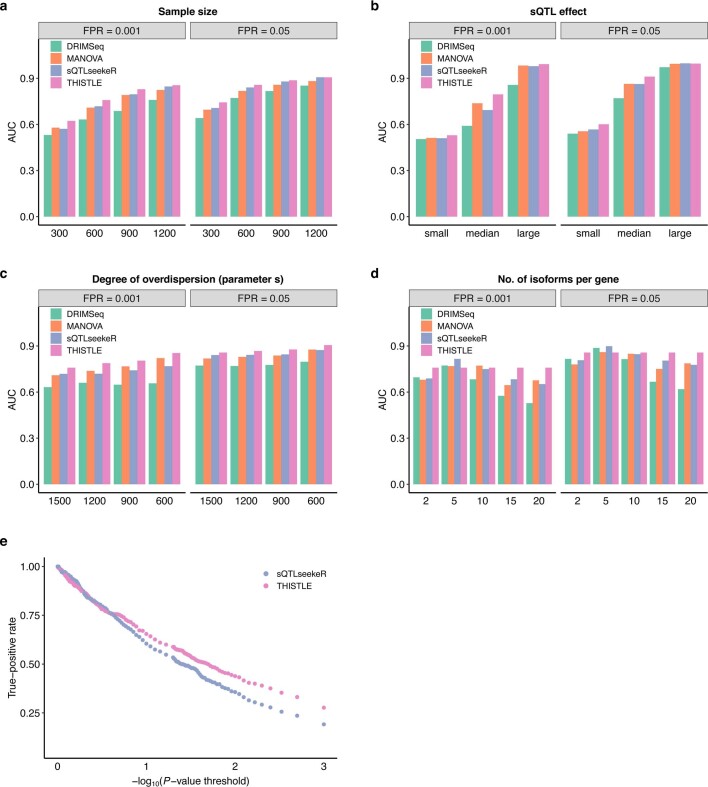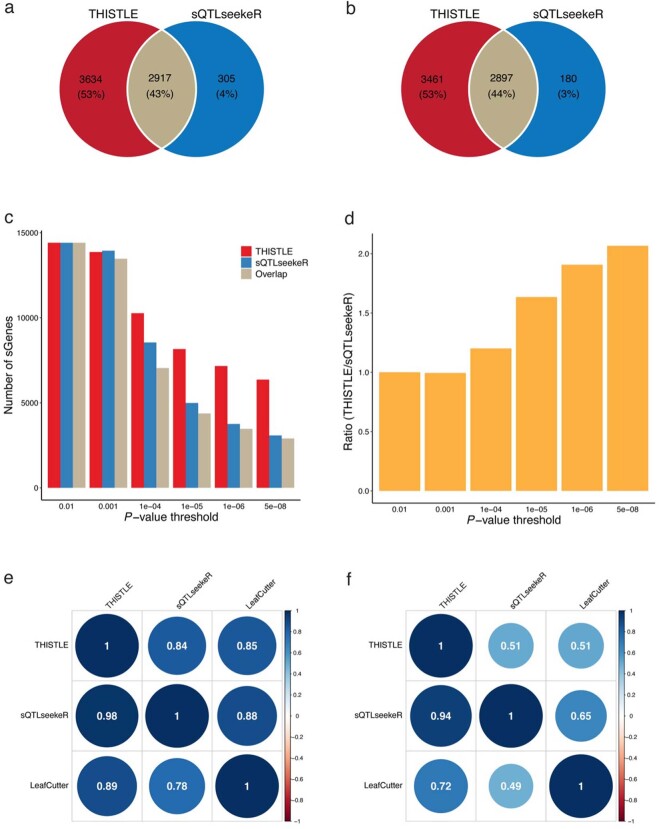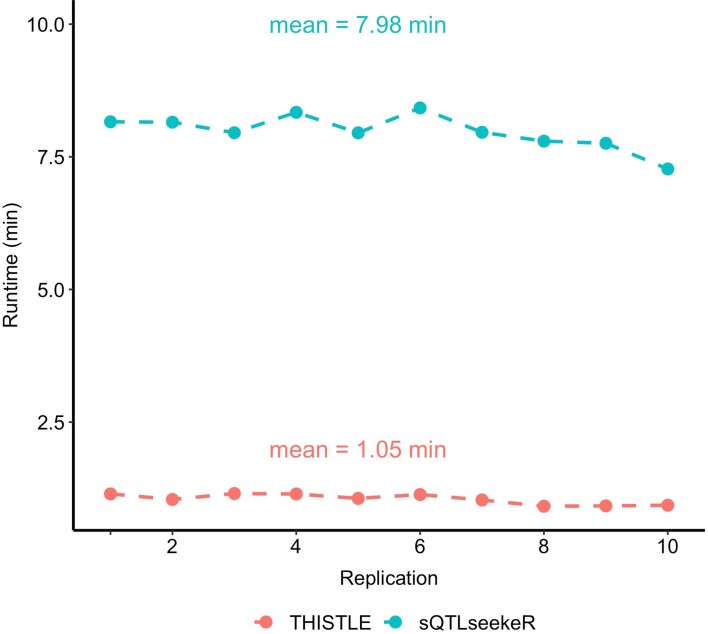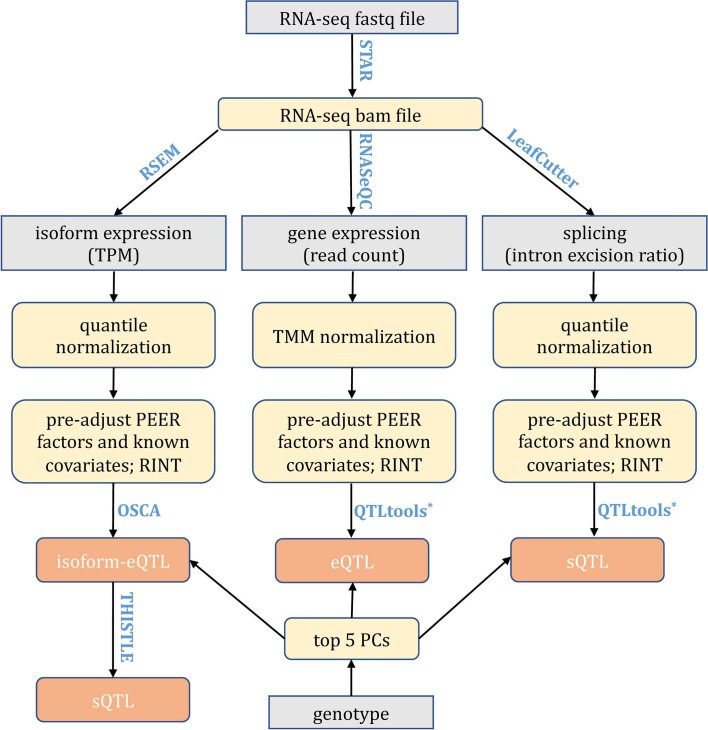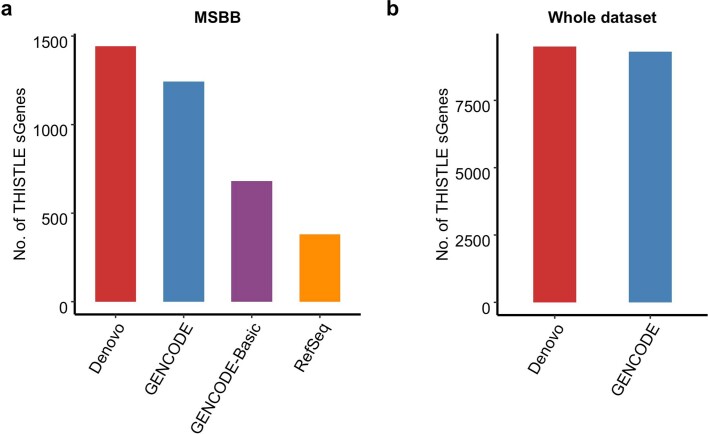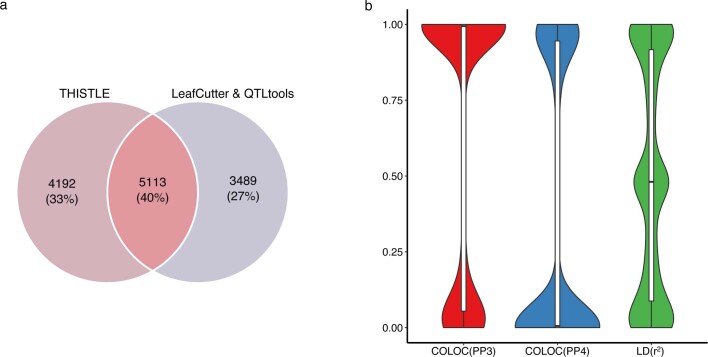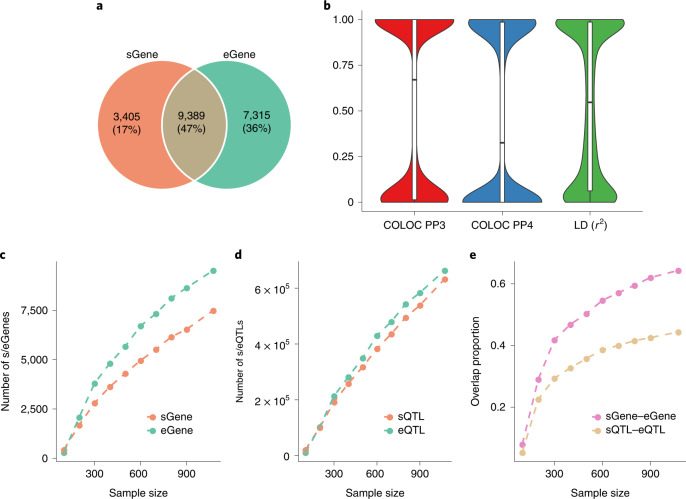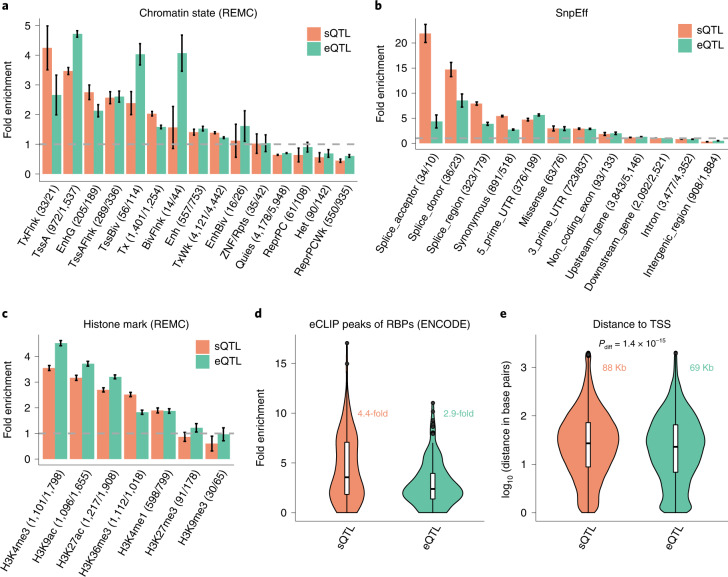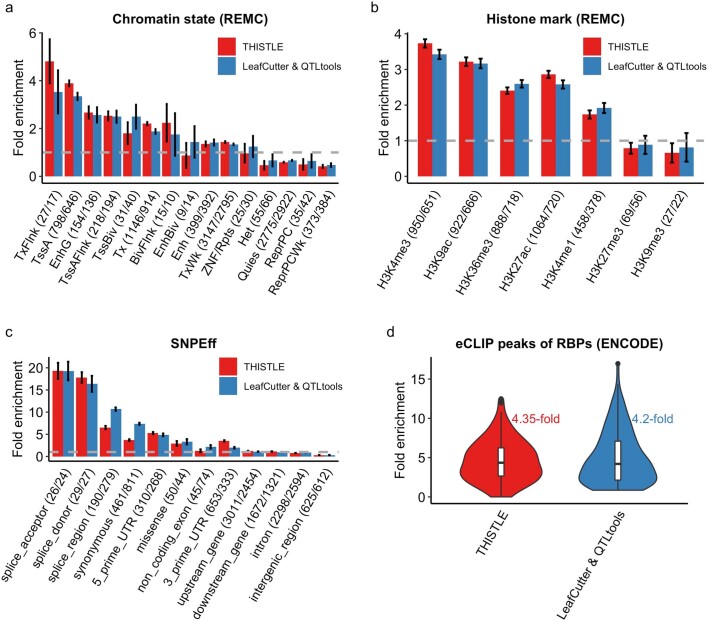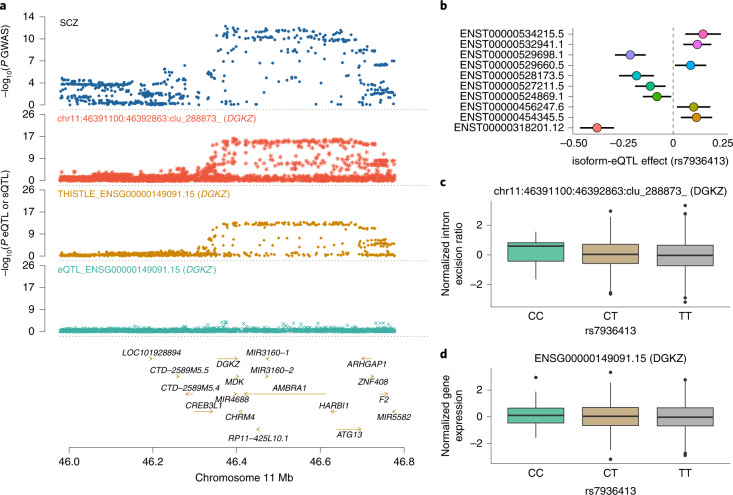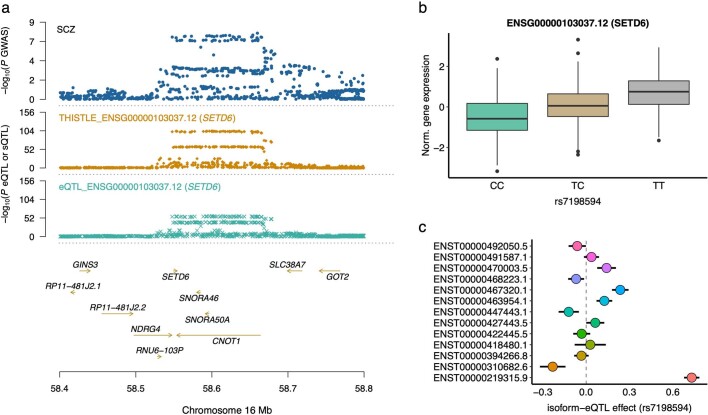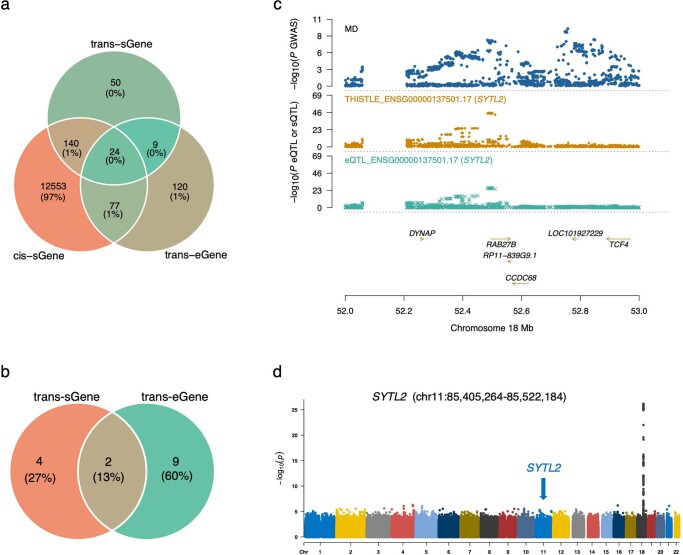Abstract
Most genetic variants identified from genome-wide association studies (GWAS) in humans are noncoding, indicating their role in gene regulation. Previous studies have shown considerable links of GWAS signals to expression quantitative trait loci (eQTLs) but the links to other genetic regulatory mechanisms, such as splicing QTLs (sQTLs), are underexplored. Here, we introduce an sQTL mapping method, testing for heterogeneity between isoform-eQTL effects (THISTLE), with improved power over competing methods. Applying THISTLE together with a complementary sQTL mapping strategy to brain transcriptomic (n = 2,865) and genotype data, we identified 12,794 genes with cis-sQTLs at P < 5 × 10−8, approximately 61% of which were distinct from eQTLs. Integrating the sQTL data into GWAS for 12 brain-related complex traits (including diseases), we identified 244 genes associated with the traits through cis-sQTLs, approximately 61% of which could not be discovered using the corresponding eQTL data. Our study demonstrates the distinct role of most sQTLs in the genetic regulation of transcription and complex trait variation.
Subject terms: Genome-wide association studies, Gene expression
A powerful method for splicing quantitative trait loci (sQTL) mapping, THISTLE, is presented and applied to a collection of 2,865 brain samples. Integration with GWAS identifies 244 genes associated via cis-sQTLs, of which 61% were not identified using expression QTLs.
Main
GWAS have led to the discovery of tens of thousands of genetic variants associated with human complex traits (including diseases)1,2. However, most of the trait-associated variants are of uncharacterized function and the mechanisms through which genetic variants exert their effects on traits are largely elusive. Considering that most of the GWAS signals are located in noncoding regions of the genome, one hypothesis is that genetic variants affect traits through genetic regulation of gene expression3,4. The effects of genetic variation on messenger RNA abundance (also known as eQTLs) have been studied for more than a decade5–7 and nearly all genes have been found with one or more genetic variants associated with their mRNA abundance6,8. These advances have propelled the development of methods9–13 to integrate eQTL data with GWAS data to prioritize the genes responsible for GWAS signals. However, only a moderate proportion of GWAS signals have been attributed to cis-eQTLs14–18, likely because of various reasons, including limited power, spatiotemporal eQTL effects that occur in specific tissues or cell types at specific developmental stages, focus on genomic regions in cis and mechanisms beyond the genetic control of mRNA abundance.
Genetic control of pre-mRNA splicing (also called sQTLs) is another fundamental mechanism of gene regulation but is heavily underexplored compared to eQTLs. Currently, there is no consensus in the literature regarding the relationship between eQTLs and sQTLs. For example, there are observations showing that sQTLs are largely independent of eQTLs6,19,20 and hypothesized to be one of the major contributors to genetic risk of disease20, whereas a recent study showed that the contribution of sQTLs to trait heritability is not statistically significant conditional on eQTLs21. These results motivated us to investigate the role of sQTLs in complex traits using a larger dataset. Depending on how alternative splicing variation is quantified, sQTL mapping strategies can be broadly classified into two categories22, that is, transcript-level23–27 or event-level28–31, each favoring different types of splicing events (Section 1 of the Supplementary Note).
In this study, we aimed to investigate the genetic control of RNA splicing by generating the largest collection of sQTLs to date and describing their role in complex trait variation. We focused our study on the brain because of data availability and the considerable links of sQTLs to neurodegenerative diseases such as Alzheimer’s disease (AD)32, schizophrenia33 and Parkinson’s disease (PD)34,35 reported recently. Recognizing the differences between transcript- and event-level sQTL mapping strategies (Section 1 of the Supplementary Note), we intended to combine the two strategies with state-of-the-art tools, that is, RSEM36 and sQTLseekeR27,37 for transcript-level analysis and LeafCutter31 and QTLtools38 for event-level analysis, to increase the yield of sQTLs. Nevertheless, the limited number of sQTLs detected by sQTLseekeR motivated us to develop a more powerful transcript-level sQTL method, THISTLE. We applied THISTLE together with LeafCutter and QTLtools to the largest publicly available brain transcriptomic data (n = 2,865) with genotype data to detect sQTLs and integrated the sQTL summary statistics into GWAS for 12 brain-related traits (including diseases) of large sample sizes (n = 51,710–766,345) to prioritize genes associated with the traits through genetic regulation of splicing. We benchmarked the role of sQTLs in complex trait variation by the eQTLs identified using the same data.
Results
Calibration of THISTLE
Details of the THISTLE method can be found in the Methods, with the schematics of the method illustrated in Fig. 1. We calibrated THISTLE using simulations in comparison with three existing sQTL methods in the same category, namely sQTLseekeR v.2 (ref. 37), DRIMSeq v.1.18 (ref. 39) and multivariate analysis of variance (MANOVA) (implemented in rrcov v.1.5.5). We first performed simulations with mRNA abundances generated from multivariate normal or Poisson distributions (Section 2 of the Supplementary Note) and focused on the comparison with sQTLseekeR. There was no inflation in false positive rate (FPR) under the null hypothesis of no sQTL effect for both THISTLE and sQTLseekeR, in either the absence or presence of an eQTL effect (Supplementary Fig. 1). The statistical power of a method is often measured by the true positive rate (TPR). We also used the area under the receiver operating characteristic curve (AUC) to measure power to account for potential inflation in FPR. Although the overall AUC for THISTLE was only slightly (4.7% on average) larger than that for sQTLseekeR, the difference in TPR between the methods increased with the −log10(P) threshold (Extended Data Fig. 1). Next, we compared all four methods using more comprehensive simulations, with mRNA abundances generated by sampling RNA sequencing (RNA-seq) reads40 in a broader range of scenarios with varying sample sizes, sQTL effect sizes, degree of overdispersion of transcription abundance and number of isoforms per gene (Section 2 of the Supplementary Note). All methods except DRIMSeq showed well-calibrated test statistics under the null hypothesis (Supplementary Fig. 2); THISTLE was more powerful than sQTLseekeR, DRIMSeq and MANOVA in most scenarios, including those in which genes were simulated with a large number of isoforms (Extended Data Fig. 2). In line with the observation above, the difference in TPR between THISTLE and sQTLseekeR increased with a more stringent P threshold (Extended Data Fig. 2e).
Fig. 1. Schematics of the THISTLE sQTL analysis.
In this toy example, a genetic variant with two alleles, G and A, is associated with a splicing event (for example, exon skipping) in a gene with two transcript isoforms, T1 and T2. a,b, Schematics of the THISTLE sQTL analysis in the absence of an eQTL effect. In this scenario, individuals with the G allele show higher mean abundance of T1 than T2 and individuals with the A allele show higher mean abundance of T2 than T1 (a), meaning that the genetic variant is associated with the difference in abundance between isoforms. In other words, there is a difference in the isoform-eQTL effect between T1 and T2 (b). However, there is no difference in overall gene expression between individuals with different alleles, meaning that this genetic variant is not an eQTL. c,d, Schematics of the THISTLE sQTL analysis in the presence of an eQTL effect. In this scenario, individuals with the G allele show similar abundance between T1 and T2 and individuals with the A allele show lower abundance of T1 than T2 (c). The isoform-eQTL effect for T1 is different from that for T2 albeit in the same direction (d). In this case, there is a difference in overall gene expression between alleles G and A, meaning that this genetic variant is also an eQTL.
Extended Data Fig. 1. Comparison of statistical power between THISTLE and sQTLseekeR by simulation with transcription abundances generated from a multivariate distribution.
Transcription abundance was simulated from either a multivariate normal distribution (panels a and c) or a multivariate Poisson distribution (panels b and d) with (scenario 4) or without an eQTL effect (scenario 3) in a sample of 500 unrelated individuals (Section 2 of the Supplementary Note). The THISTLE and sQTLseekeR p-values were computed from a one-sided sum of chi-squared test (approximated by the Saddlepoint algorithm) and pseudo-F test (approximated by the Davies algorithm), respectively.
Extended Data Fig. 2. Comparison of statistical power between DRIMSeq, MANOVA, sQTLseekeR, and THISTLE by simulation with transcription abundances generated from RNA-seq reads.
Panels a, b, c and d show the results from 500 simulation replicates to quantify the power, measured by AUC truncated at FPR = 0.05 or 0.001, for DRIMSeq, and MANOVA, sQTLseekeR, and THISTLE. Panel e shows the result from 500 simulation replicates to quantify the power, measured by TPR at different levels of p-value threshold, for sQTLseekeR and THISTLE. Transcriptional abundance data of 500 unrelated individuals were generated by sampling RNA-seq reads to mimic real RNA-seq data using Polyester (Section 2 of the Supplementary Note). The simulations were performed with varying a) sample size, b) sQTL effect size, c) the degree of overdispersion of transcription abundances, and d) the number of isoforms per gene. When one simulation parameter was fixed (for example, in panel a, all the other parameters were randomly sampled from the specified categories, for example, the sQTL effect size from {small, median, or large}, the number of isoforms per gene from {2, 5, 10, 15, or 20}, and the degree of over-dispersion of transcriptional abundance from {600, 900, 1200, or 1500}. The DRIMSeq, MANOVA, sQTLseekeR, and THISTLE p-values were computed using a one-sided likelihood ratio test, F test, pseudo-F test, and sum of chi-squared test, respectively.
An increase of difference in power between THISTLE and sQTLseekeR with the increased −log10(P) threshold was also observed (even more prominently) in the real-data analysis. For instance, in the analysis of the Religious Orders Study and Memory and Aging Project (ROSMAP) data (n = 832), 6,358 genes with 795,592 unique sQTL SNPs (no linkage disequilibrium (LD) clumping) were discovered by THISTLE versus 3,077 genes with 390,497 sQTL SNPs by sQTLseekeR using a P threshold of 5 × 10−8 (Methods, Extended Data Fig. 3b and Section 3 of the Supplementary Note), a 2.1- and 2.0-fold difference in the number of sGenes and sQTL SNPs, respectively. In this article, we refer to genes with a significant sQTL as sGenes. The ratio decreased to 1.9 at P < 1 × 10−6, to 1.2 at P < 1 × 10−4 and eventually to nearly 1 at P < 1 × 10−3 (Extended Data Fig. 3d). Analysis of the ROSMAP data without covariate adjustment led to a decreased number of sGenes for both methods but the ratio of THISTLE to sQTLseekeR was 1.7 at P < 5 × 10−8. Despite the differences, there was a strong overlap between the sQTLseekeR and THISTLE sQTL results (Extended Data Fig. 3e), the splicing events captured by THISTLE were similar to those by sQTLseekeR (Supplementary Fig. 3) and the THISTLE P values computed from the saddlepoint approximation41 were remarkably consistent with those from the Davies method42 used in the latest version of sQTLseekeR (Supplementary Fig. 4). Moreover, benchmarked on a computing platform with 16 GB memory and 16 central processing unit cores, the overall runtime of THISTLE (including the time to estimate the isoform-eQTL effects) in the analysis of the ROSMAP data with 382 genes and 109,853 SNPs on chromosome 22 was 1.05 min (averaged from 10 repeats), approximately 7.6 times faster than sQTLseekeR (Extended Data Fig. 4). In addition, the performance of THISTLE using individual-level SNP genotype and RNA-seq data was similar to that using summary-level isoform-eQTL data (Supplementary Fig. 5).
Extended Data Fig. 3. Comparison between sQTL results from the sQTLseekeR, THISTLE, and LeafCutter & QTLtools analyses of real data.
The analyses were performed with the ROSMAP data (n = 832). Panel a shows the numbers of overlapping sGenes between THISTLE and sQTLseekeR. Panel b shows the numbers of overlapping sGenes considering only the SNP-gene pairs tested in common between THISTLE and sQTLseekeR. Panel c shows the number of sGenes discovered at different p-value thresholds for THISTLE and sQTLseekeR. Panel d shows the ratio of the number of sGenes identified by THISTLE to that by sQTLseekeR at different p-value thresholds. Panels e and f show the replication rates of the lead cis-sQTL SNPs at PsQTL < 0.05 and PsQTL < 0.05/m (where m is the number of SNPs taken forward for replication for each method), respectively. Each row represents an analysis from which the lead cis-sQTL SNPs (one SNP per gene) were identified (), and each column represents an analysis in which the SNPs were replicated. The THISTLE, sQTLseekeR, and LeafCutter & QTLtool p-values were computed using a one-sided sum of chi-squared test, pseudo-F test, and chi-squared test, respectively.
Extended Data Fig. 4. Comparison of runtime between THISTLE and sQTLseekeR.
We benchmarked the runtime of THISTLE (implemented in OSCA) on a computing platform with 16 GB memory and 16 CPU cores, in comparison with sQTLseekeR2-nf, using the ROSMAP data (n = 832) with 382 genes and 109,853 SNPs on chromosome 22. We repeated each analysis with 10 replicates.
Identifying cis-sQTLs in the brain
We applied THISTLE to ten brain transcriptomic datasets from seven cohorts. After quality control (Methods, Extended Data Fig. 5, Supplementary Figs. 6 and 7 and Section 4 of the Supplementary Note), we included in the analysis RNA-seq data of 2,865 samples from 2,443 unrelated individuals of European ancestry and genetic data of approximately 12 million variants with a minor allele frequency (MAF) > 0.01 (Supplementary Table 1). In total, we identified 1,342,073 unique cis-sQTL SNPs with PsQTL < 5 × 10−8 for 9,305 genes (Supplementary Table 2). We focused most of the subsequent analyses on the sQTLs with PsQTL < 5 × 10−8 for two reasons: (1) it is the most commonly used genome-wide significance threshold in GWAS and the default threshold used in summary-data-based Mendelian randomization (SMR) to select instrument SNPs11 (see below); (2) it was more stringent than the permutation-based P threshold in all the 10 datasets and the sQTLs with PsQTL < 5 × 10−8 represented a large proportion of the sQTLs with a false discovery rate (FDR) < 0.05 (Section 5 of the Supplementary Note and Supplementary Table 3). Of the 9,305 sGenes detected at PsQTL < 5 × 10−8, 220 (2.4%) were lowly expressed in the brain with median transcripts per million (TPM) <0.1 (Supplementary Fig. 8b). Moreover, by comparing the number of sGenes identified above (based on GENCODE v.37) with those based on three other transcriptome references (RefSeq, GENCODE v.37 Basic, which includes only a subset of representative transcripts for each gene, and de novo assembly), we showed that GENCODE v.37 substantially outperformed RefSeq and GENCODE v.37 Basic and that de novo assembly gave rise to only approximately 4% more sGenes (Extended Data Fig. 6). Considering the small gain and potential errors in de novo assembled transcripts, we opted to use the GENCODE v.37 results in the following analyses.
Extended Data Fig. 5. Workflow of the sQTL and eQTL analyses in this study.
RINT: rank-based inverse normal transformation. * Note: we have implemented the QTLtools QTL mapping method (linear regression) in OSCA and used the two tools interchangeably, for example, OSCA for real data analysis to save the sQTL or eQTL mapping results in SMR BESD format and QTLtools for eQTL or Leafcutter sQTL permutation analysis.
Extended Data Fig. 6. Number of sGenes identified by THISTLE based on four different transcriptome references.
The four transcriptome references are RefSeq, GENCODE-Basic (v37), GENCODE (v37), and de novo assembly (constructed from the RNA-seq data using StringTie based on GENCODE). Panel a shows the comparison in the number of sGenes in the MSBB cohort (n = 183), and panel b shows the comparison in the whole dataset (n = 2,865).
Next, we used LeafCutter to detect splicing events that might not be well captured by transcript-level analysis (Methods, Extended Data Fig. 5 and Supplementary Fig. 7). Overall, we identified 1,371,483 unique cis-sQTL SNPs for 15,136 intron clusters in 8,602 genes at PsQTL < 5 × 10−8 (Supplementary Table 2) and 203,889 unique cis-sQTL SNPs for 1,148 intron clusters with unknown associated genes. Of the 8,602 sGenes detected at PsQTL < 5 × 10−8, 174 genes (2.1%) were lowly expressed in the brain (Supplementary Fig. 8c). As above, the P threshold of 5 × 10−8 was more stringent than the permutation-based P threshold at an FDR < 0.05 in all 10 datasets (Supplementary Table 3).
Combining the sQTL results from THISTLE and LeafCutter and QTLtools, there were 1,864,200 unique cis-sQTL SNPs for 12,794 sGenes at PsQTL < 5 × 10−8 compared with 462,722 unique sQTL SNPs for 7,296 sGenes from the largest previous study43,44 (Section 6 of the Supplementary Note, Supplementary Fig. 9 and Supplementary Table 4). There were 4,192 and 3,489 sGenes unique to THISTLE and LeafCutter and QTLtools, respectively, and 5,113 common sGenes for both (Extended Data Fig. 7a). For 2,858 of the 5,113 common sGenes, the THISTLE sQTL signal was distinct from the LeafCutter and QTLtools sQTL signal as indicated by a COLOC9 PP3 value >0.8 (Supplementary Fig. 10), in line with many common sGenes for which the lead sQTL SNPs from the 2 methods were in low-to-moderate LD (Extended Data Fig. 7b). Together with the large proportions of method-specific sGenes, this result suggests that most sQTL signals detected by THISTLE and LeafCutter and QTLtools were distinct, demonstrating the benefit of using a combination of the two sQTL mapping strategies.
Extended Data Fig. 7. Comparison between the sQTLs results from THISTLE and LeafCutter & QTLtools.
a) Comparison between the sGenes identified by THISTLE and LeafCutter & QTLtools. b) COLOC PP3 and PP4 values between the THISTLE and LeafCutter & QTLtools sQTL signals, and LD r2 between the lead THISTLE and LeafCutter & QTLtools cis-sQTL SNPs for 5,113 overlapping sGenes. In panel b, the bold line inside each box indicates the median value, notches indicate the 95% confidence interval (CI), the central box indicates the interquartile range (IQR), and whiskers indicate data up to 1.5 times the IQR.
Quantifying the relationship between sQTLs and eQTLs
To assess the relationship between sQTLs and eQTLs, we performed an eQTL analysis using the same data as above (Methods and Extended Data Fig. 5) and identified 1,962,048 unique cis-eQTL SNPs with PeQTL < 5 × 10−8 for 16,704 genes (Supplementary Table 2). Similarly, we refer to genes with a significant eQTL as eGenes. We found that 73% (9,389 out of 12,794) of the sGenes were also eGenes (Fig. 2a), a proportion much higher than that (50%) reported in a recent study using transcriptomic data from the fetal brain19. We hypothesized that the difference is due to the larger sample size (n) used in our study than that in the fetal brain study (n = 233). To test this hypothesis, we used a downsampling strategy to assess the sGene–eGene overlap in several subsets of data with n ranging from 100 to 1,073. The result showed that the power of either sGene or eGene discovery was proportional to n and that the difference in discovery power between sGene and eGene increased with increasing n (Fig. 2c,d), in line with the observation from previous work6. We also found that the sGene–eGene overlap was positively correlated with n (Fig. 2e), which is expected if most genes have both eQTLs and sQTLs. Of the 9,389 overlapping genes, there were 4,377 genes for which the sQTL signal was distinct from the eQTL signal as indicated by a COLOC PP3 value >0.8, in line with a large proportion of overlapping genes for which the lead sQTL SNP was in low-to-moderate LD with the lead eQTL SNP (Fig. 2b). The result was largely unchanged when we performed the colocalization analysis with eCAVIAR12 that accounts for multiple causal variants at a locus (Supplementary Fig. 11). In summary, although a large proportion of sGenes are expected to be eGenes with large n and this proportion increases with increasing n, most sQTLs are distinct from eQTLs (an estimate of approximately 61%, (4,377 + 3,405)/12,794 in this study, with 3,405 being the number of genes that are sGenes only).
Fig. 2. Relationship between sQTLs and eQTLs.
a, Overlap between sGenes and eGenes. b, COLOC PP3 and PP4 values between the cis-sQTL and cis-eQTL signals and LD r2 between the lead cis-sQTL and cis-eQTL SNPs for the 9,389 overlapping genes. The line inside each box indicates the median value, the notches indicate the 95% confidence interval (CI), the central box indicates the interquartile range (IQR) and the whiskers indicate data up to 1.5 times the IQR. c, The number of sGenes (or eGenes) discovered as a function of sample size. d, The number of sQTLs (or eQTLs) discovered as a function of sample size. e, The overlap between sGenes and eGenes (or between sQTLs and eQTLs) as a function of sample size, where sQTL–eQTL overlap is defined as the proportion of sGenes for which the lead sQTL SNP is a significant eQTL SNP for the same gene.
sQTLs are enriched for splicing and RNA-binding protein binding sites
Having shown that sQTLs were largely distinct from eQTLs (Fig. 2), we then asked whether sQTLs and eQTLs show different patterns of functional enrichment. To do this, we annotated the lead SNP for each of the 12,794 sGenes and 16,704 eGenes using SnpEff45, functional annotation data of 113 RNA-binding protein (RBP) binding sites46, 7 histone marks47 and 15 chromatin states47 (Methods). The fold enrichment was computed as the proportion of sQTLs or eQTLs in a functional category divided by the mean of a null distribution generated by resampling ‘control’ SNPs with MAF and distance to the transcription start site (TSS) matched to the SNPs in question (Methods and Section 7 of the Supplementary Note). The results showed that sQTLs were more enriched in splicing sites (for example, splice acceptors and splice donors) and RBP binding sites than eQTLs (Fig. 3b,d). eQTLs were more enriched in the TSS than sQTLs (for example, active TSS and bivalent TSS; Fig. 3a), which is consistent with our observation that eQTLs were located much closer to the TSS than sQTLs (Fig. 3e). Both sQTLs and eQTLs tended to be enriched at both ends of gene bodies, exons and introns (Supplementary Fig. 12) and were significantly enriched in the histone marks H3K4me3, H3K9ac, H3K27ac, H3K36me3 and H3K4me1 (Fig. 3c) but depleted in noncoding regions (Fig. 3b). Compared to that of eQTLs, the enrichment of the sQTLs was higher in H3K36me3 but lower in H3K4me3, H3K9ac or H3K27ac (Fig. 3c). The functional enrichment patterns were largely unchanged whether we stratified the sQTLs by mapping strategy (Extended Data Fig. 8) or performed the enrichment analysis with TORUS48 using the full summary statistics without SNP selection (Supplementary Fig. 13).
Fig. 3. Enrichment of the lead cis-sQTL or cis-eQTL SNPs in functional annotation categories.
a–d, The annotation categories were defined by the chromatin state annotation data from REMC (a), predicted variant functions by SnpEff (b), histone marks from REMC (c) and eCLIP peaks of 113 RBP binding sites from ENCODE (d). a–c, The fold enrichment was computed by dividing the percentage of lead cis-sQTL (or cis-eQTL) SNPs in a category by the mean percentage observed in 1,000 sets of control SNPs sampled repeatedly at random (Methods). Each column represents an estimate of fold enrichment with an error bar indicating the 95% CI of the estimate. The gray dashed line represents no enrichment. The numbers in parentheses are the number of sQTL/eQTL SNPs in each functional category. d, The text in color represents the median across 113 RBP binding sites. e, Distance of the lead cis-sQTL (or cis-eQTL) SNP to the TSS of the gene. The texts in color represent the median across 12,794 sGenes and 16,704 eGenes, respectively; Pdiff was computed from a two-sided t-test for a mean difference between the two groups. d,e, The violin plots show the distributions of fold enrichment estimates of sQTL and eQTL SNPs across the 113 RBP biding sites (d) or distances to the TSS across 12,794 sGenes and 16,704 eGenes (e), respectively. The line inside each box indicates the median value, the notches indicate the 95% CI, the central box indicates the IQR, the whiskers indicate data up to 1.5 times the IQR and the outliers are shown as separate dots.
Extended Data Fig. 8. Enrichment of the lead THISTLE or LeafCutter & QTLtools cis-sQTL SNPs in functional annotation categories.
The annotation categories were defined by the chromatin state annotation data from REMC (a), histone marks from REMC (b), predicted variant functions by SNPEff (c), or eCLIP peaks of 113 RBPs binding sites from ENCODE (d). The fold enrichment was computed by dividing the percentage of lead cis-sQTL SNPs in a category by the mean percentage observed in 1,000 sets of control SNPs sampled repeatedly at random (Methods). Each column represents a point estimate with an error bar indicating the 95% CI of the estimate. The grey dashed line represents no enrichment. The numbers in the parentheses are the numbers of THISTLE/LeafCutter & QTLtools sQTL SNPs in each functional category. In panel d, a violin plot shows the distribution of fold enrichment estimates across 113 RBPs binding sites. The line inside each box indicates the median value, notches indicate the 95% CI, the central box indicates the IQR, whiskers indicate data up to 1.5 times the IQR, and outliers are shown as separate dots.
Enrichment of sQTLs for trait heritability
We next tested whether the brain cis-sQTLs are enriched for genetic variants associated with complex traits and disorders related to the brain. We acquired GWAS summary statistics for 12 brain-related traits from previous work49–60 (Methods and Supplementary Table 5). Both sQTLs and eQTLs showed more inflated GWAS test statistics compared to the other SNPs for all 12 traits (Supplementary Fig. 14) and the levels of inflation were indistinguishable between sQTLs and eQTLs (Supplementary Fig. 15). We then performed a stratified LD score regression61,62 analysis to quantify the enrichment of the lead cis-sQTL SNPs for heritability in comparison with that of the lead cis-eQTL SNPs when fitted together with 53 other functional categories in the ‘baseline-LD model’61 (Methods). The results showed that the sQTLs were significantly enriched for heritability for most traits and the fold enrichment of sQTLs was comparable to (even appeared to be higher than) that of eQTLs on average across traits (Supplementary Fig. 16 and Fig. 4a). Considering that the lead SNPs were ascertained in the cis-regions known to explain disproportionately more trait variation than intergenic regions63, we adjusted the heritability enrichment by the control SNPs mentioned above (Methods). Under this stringent definition, the overall levels of enrichment decreased but the fold enrichment of sQTLs was comparable to that of eQTLs on average across traits (Fig. 4b). We further performed sensitivity analyses to quantify the heritability enrichment at all the significant, LD-clumped or fine-mapped cis-sQTL (or cis-eQTL) SNPs21; the results consistently showed comparable levels of heritability enrichment between sQTLs and eQTLs (Supplementary Figs. 17b, 18b and 19b). We showed that the τ estimates for the cis-sQTLs and cis-eQTLs were significant for most traits (Methods, Fig. 4c and Supplementary Figs. 17c, 18c and 19c), indicating their distinct contributions to trait heritability. We also attempted to estimate the proportion of heritability mediated by the cis-sQTLs and cis-eQTLs () by the mediated expression score regression18 method and observed a median estimate of of 0.09 and 0.11 across traits for the cis-sQTLs and cis-eQTLs, respectively (Fig. 4d), where the estimate for the cis-eQTLs was similar to that reported previously18. Overall, the analyses above suggest a unique role of sQTLs in complex trait variation, at a level comparable to that of eQTLs (see below for further discussion).
Fig. 4. Enrichment of the lead cis-sQTL or cis-eQTL SNPs for heritability of the 12 brain-related traits.
a, is a ratio of heritability attributable to the SNPs in query to the overall SNP-based heritability (). b, Heritability enrichment is defined as a ratio of the proportion of heritability explained by the SNPs in query to the mean proportion observed in 1,000 sets of control SNPs sampled repeatedly at random (Methods). a,b, The blue dashed line represents the median value across traits; each column represents a point estimate with an error bar indicating the 95% CI of the estimate. c, The stratified LD score regression parameter τ was used to assess the contribution of the lead cis-sQTL SNPs to heritability when fitted jointly with the lead cis-eQTL SNPs. d, Proportion of heritability mediated by the cis-sQTL (or cis-eQTL) SNPs (), estimated by the mediated expression score regression. Only the sQTLs discovered by LeafCutter and QTLtools were included in the mediated expression score regression analysis. c,d, The violin plots show the distributions of the estimates of τ and , respectively, across the 12 traits. The line inside each box indicates the median value, the notches indicate the 95% CI, the central box indicates the IQR, the whiskers indicate data up to 1.5 times the IQR and the outliers are shown as separate dots. e, Overlap between the trait-associated sGenes and eGenes identified by SMR and COLOC PP4.
Identifying complex trait genes using cis-sQTL data
To leverage the cis-sQTLs to prioritize functional genes for the 12 brain-related traits, we applied the SMR approach11 to test if an sGene is associated with a trait through sQTL and the COLOC9 PP4 statistic to assess whether the sGene-trait association is driven by the same set of causal variants. SMR testing is typically followed by the heterogeneity in dependent instruments (HEIDI) test to distinguish whether the gene-trait association is because of shared or distinct causal variants11. However, the HEIDI test requires signed SNP effect estimates, which are unavailable for the THISTLE sQTLs. Instead, we used COLOC PP4, which requires only GWAS and xQTL P values as a replacement (Supplementary Fig. 20). We identified 773 sGene-trait associations (585 unique genes) in total for the 12 traits at a genome-wide significance level (PSMR < 1.1 × 10−6 for the LeafCutter and QTLtools sQTLs and PSMR < 5.7 × 10−6 for the THISTLE sQTLs), 270 (244 unique genes) of which showed a COLOC PP4 value >0.8 (Fig. 4e and Supplementary Table 6), which is consistent with a plausible mechanism that genetic variants affect a trait through genetic control of splicing. We also included the eQTL data in the SMR analysis and identified 805 eGene-trait associations (577 unique genes; PSMR < 3.2 × 10−6), 246 (226 unique genes) of which reached PP4 >0.8 in COLOC (Fig. 4e and Supplementary Table 6). Between the two sets of trait-associated genes discovered through sQTLs and eQTLs, respectively, 96 genes were in common, meaning that we identified 148 more genes through sQTLs on top of the 226 genes identified through eQTLs (Fig. 4e), an approximate 65% increase. One of the examples is DGKZ (Fig. 5), the functional relevance of which to schizophrenia (SCZ) has been implicated in previous work64,65. In this study, DGKZ was associated with SCZ using the sQTL data, implying a possible mechanism that the SNP effects on SCZ are mediated by genetic regulation of RNA splicing of DGKZ. Notably, no genome-wide-significant eQTL was associated with the overall expression level of DGKZ in our dataset (Fig. 5d), meaning that DGKZ would have been missed if we had analyzed the eQTL data only. In addition, the analysis with FOCUS66 prioritized 298 sGenes for the traits, approximately 80% of which were not identified through eQTLs (Supplementary Fig. 21 and Supplementary Table 7). In summary, approximately 61% (148 out of 244) of the trait-associated sGenes were not detected using eQTL data, which again suggests the distinct role of sQTLs in complex traits. This proportion was similar (approximately 62%) in the analysis with 7 additional traits67–69 (not limited to the brain) for which summary statistics from large GWAS (n > 600,000) were available (Supplementary Fig. 22).
Fig. 5. Association of DGKZ with SCZ through alternative splicing rather than overall mRNA abundance.
a, GWAS, sQTL and eQTL P values. The top track shows −log10(P) of SNPs from the SCZ GWAS. The second, third and fourth tracks show −log10(P) from the LeafCutter and QTLtools sQTL (intron 11:46391100:46392863:clu_288873_), THISTLE sQTL and eQTL analyses, respectively, for DGKZ. The THISTLE sQTL P values were computed using a one-sided sum of chi-squared test and the eQTL and LeafCutter and QTLtools sQTL P values were computed using a one-sided chi-squared test. b, Isoform-eQTL effects for DGKZ in the whole dataset (n = 2,865), with ENST00000318201.12 and ENST00000534125.5 at the 2 extremes with opposite isoform-eQTL effects. Each dot represents an estimate of the isoform-eQTL effect with an error bar indicating the 95% CI of the estimate. c,d, Association of rs7936413 (the lead LeafCutter and QTLtools sQTL SNP) with an excision ratio of 11:46391100:46392863:clu_288873_ and overall mRNA abundance of DGKZ, respectively, in the ROSMAP data. Each box plot shows the distribution of intron excision ratios (c) or mRNA abundances (d) in a genotype class, that is, CC (n = 21), CT (n = 218) or TT (n = 593). The line inside each box indicates the median value, the notches indicate the 95% CI, the central box indicates the IQR, the whiskers indicate data up to 1.5 times the IQR and the outliers are shown as separate dots.
For each of the 96 trait-associated genes that could be identified by using either the sQTL or eQTL data (Fig. 4e), we further performed a COLOC analysis to test whether the sQTL and eQTL signals were driven by the same or distinct causal variants. We found 80 genes with PP4 >0.80. One typical example is SETD6, for which the COLOC analysis (PP4 = 0.98) suggested that the sQTL, eQTL and SCZ GWAS signals are all driven by the same causal variant(s) (Extended Data Fig. 9). On the other hand, there were 8 genes with PP3 > 0.8, indicating multiple GWAS signals at a locus mediated through distinctive genetic regulatory mechanisms (see Supplementary Fig. 23 for a typical example). Note that fewer genes with distinctive sQTL and eQTL signals were linked to the traits than those with a shared sQTL/eQTL signal because it was less likely to link the distinct signals consistently to multiple GWAS signals at a locus. Taken together, our results show the distinctiveness of most sQTLs in mediating the polygenic effects for complex traits and demonstrate the substantial gain of power in gene discovery for complex traits by integrating sQTL data into GWAS.
Extended Data Fig. 9. Association of SETD6 with schizophrenia identified using either sQTL or eQTL data.
a) The top track shows −log10(p-values) of SNPs from the schizophrenia GWAS. The second and third tracks show −log10(p-values) from the THISTLE sQTL and eQTL analyses, respectively. The THISTLE sQTL and eQTL p-values were computed using a one-sided sum of chi-squared test and chi-squared test, respectively. b) Association of rs7198594 (the lead eQTL SNP) with the overall mRNA abundance of SETD6 in the ROSMAP data (n = 832). Each boxplot shows the distribution of mRNA abundances in a genotype class, that is, CC (n = 288), CT (n = 392), or TT (n = 152). The line inside each box indicates the median value, notches indicate the 95% CI, the central box indicates the IQR, whiskers indicate data up to 1.5 times the IQR, and outliers are shown as separate dots. c) Isoform-eQTL effects for SETD6 in the whole dataset (n = 2,865), with ENST00000310682.6 and ENST00000219315.9 at the two extremes with opposite isoform-eQTL effects. Each dot represents an estimate of isoform-eQTL effect with an error bar indicating the 95% CI of the estimate.
Identifying complex trait genes using trans-sQTL data
We further performed trans-sQTL and trans-eQTL analyses, focusing on SNPs >5 megabases (Mb) apart or on a different chromosome. After cross-mapping filtering70, we identified 1,161 unique trans-sQTL SNPs with P < 1.72 × 10−10 for 53 trans-sGenes by THISTLE and 2,716 trans-sQTL SNPs with P < 2.75 × 10−11 for 186 trans-sGenes by LeafCutter and QTLtools at 5% FDR, with an overlap of 16 genes (Supplementary Fig. 24a). Of the 223 trans-sGenes, 164 were also cis-sGenes (Extended Data Fig. 10a). We also identified 15,799 trans-eQTL SNPs with P < 1.72 × 10−10 for 230 trans-eGenes at 5% FDR (Supplementary Fig. 24b), 33 of which were trans-sGenes (Extended Data Fig. 10a). Integrating the trans-sQTL/eQTL data with the GWAS data as above, we prioritized 6 sGenes and 11 eGenes, with only 2 genes in common (see Extended Data Fig. 10c,d for one example).
Extended Data Fig. 10. Trans-sQTL analysis.
a) Overlaps between trans-sGenes, cis-sGenes, and trans-eGenes. b) Overlap of the trait-associated trans-sGenes and trans-eGenes identified by SMR & COLOC PP4. c) Association of SYTL2 with major depression (MD) through both the trans-sQTLs and trans-eQTLs. The top track shows −log10(p-values) of SNPs from the MD GWAS. The second and third tracks show −log10(p-values) from the THISTLE trans-sQTL and trans-eQTL analyses, respectively, for SYTL2. d) Manhattan plot of p-values from genome-wide THISTLE sQTL analysis for SYTL2. The blue arrow indicates the genomic position where SYTL2 is located. The GWAS and eQTL p-values in panel c were computed using a one-sided chi-squared test, and the THISTLE sQTL p-values in panels c and d were computed using a one-sided sum of chi-squared test.
Discussion
In this study, we generated a comprehensive catalog of genetic variants associated with a broad spectrum of alternative splicing events in the human brain, significantly expanding our understanding of genetic control of RNA splicing. We demonstrated the benefit of using transcript- and event-level sQTL mapping strategies in combination for sQTL detection (Section 8 of the Supplementary Note). By comparing sQTLs with the eQTLs identified in this study, we showed that approximately 61% of sQTLs are distinct from eQTLs, suggesting that sQTL mapping warrants more attention in future research. By integrating sQTLs with GWAS data for 12 brain-related traits, approximately 61% of the trait-associated genes identified through sQTLs could not be discovered through eQTLs, demonstrating the distinct contribution of sQTLs to the genetic architecture underpinning complex trait variation. Moreover, the trait-associated genes identified through sQTLs in this study provide important leads for further mechanistic work to elucidate their functions in the development of the brain-related traits and disorders.
We developed an online tool (https://yanglab.westlake.edu.cn/data/brainmeta) to visualize or download the sQTL and eQTL summary statistics generated in this study. These datasets may be helpful for future studies to understand the molecular mechanisms underpinning the genetic regulation of splicing in the brain, identify functional genes and variants for other brain-related phenotypes and improve genomic risk prediction. Our study also informs future analyses to quantify the relationship between sGenes and eGenes, between sQTLs and eQTLs or more generally between any two types of molecular QTLs. We showed that the low-to-moderate sGene–eGene overlap as observed in previous studies6,20 is due to small n because the overlap is a function of n (Fig. 2). For example, only approximately 8% of sGenes are eGenes when n = 100 and this proportion increases to 64% as n increases to 1,073. Nevertheless, even for overlapping genes, the underlying sQTL and eQTL causal variants can be distinct. In this study, we estimated that the sQTL and eQTL causal variants were shared (PP4 > 0.8) for only approximately 42% (= 3980/9389) of the overlapping genes (Fig. 2b). This 42% may even be an overestimation because of the limited power of the COLOC PP4 statistic in distinguishing close linkage from sharing, especially when n is not sufficiently large. In an extreme scenario where sQTL and eQTL causal variants are in perfect LD, there is no power to distinguish linkage from sharing.
By integrating the sQTLs with GWAS data, we confirmed that the sQTLs were enriched for genetic variants associated with complex traits, as in previous studies19,20,32–34. We note that a previous study by Hormozdiari et al.21. showed that sQTLs do not have a significant contribution to disease heritability in a joint analysis of five BLUEPRINT molecular QTLs, namely eQTL, sQTL, H3K27ac histone QTL, H3K4me1 histone QTL and DNA methylation QTL, which is not consistent with our result. The discrepancy is likely due to the small sample sizes of the molecular QTL data in Hormozdiari et al. (n = approximately 200 per cell type). In the present study, we provided multiple lines of evidence that the role of sQTLs in complex trait variation is largely distinct from that of eQTLs. First, approximately 61% of the sQTL and eQTL signals were distinct (Fig. 2). Second, sQTLs contributed significantly to trait heritability conditional on eQTLs (Fig. 4c). Third, approximately 61% of the trait-associated genes detected by integrating GWAS data with sQTLs were not detected by using eQTLs (Fig. 4e). Our results also imply that the contribution of sQTLs in mediating polygenic effects was comparable to that of eQTLs. For example, we observed that the inflation in GWAS test statistics at the sQTLs was indistinguishable from that at the eQTLs (Supplementary Fig. 15), that heritability enrichment of sQTLs was similar to that of eQTLs (median fold enrichment of 2.4 for sQTLs versus 1.8 for eQTLs across traits), that the proportion of mediated heritability for the traits through cis-sQTLs was on a par with that through cis-eQTLs (median of 0.09 for sQTLs versus 0.11 for eQTLs across traits) and that the number of trait-associated genes identified through sQTLs was also similar to that through eQTLs (244 versus 226). Hence, large-scale sQTL studies in blood and other tissues or specific cell types are urgently needed to discover more sQTLs to improve our understanding of genetic regulation of RNA splicing and facilitate the translation of GWAS signals into mechanisms.
Despite the potential limitations (Section 9 of the Supplementary Note), our study developed a powerful and flexible sQTL mapping method, generated a comprehensive set of sQTL summary data (with an online tool for data query), demonstrated an analysis paradigm to assess the relationship between two types of molecular QTLs and provided multiple lines of evidence that most sQTLs are distinct from eQTLs, including their roles in complex trait variation.
Methods
Ethical approval
This study was approved by the Ethics Committee of Westlake University (approval no. 20200722YJ001) and the University of Queensland Human Research Ethics Committee B (approval no. 2011001173).
THISTLE
For ease of understanding, let us take a gene with two transcript isoforms as an example. If a genetic variant is associated with a splicing event, the variant is expected to be associated with the difference in mature mRNA abundance between the two transcript isoforms (Fig. 1). Hence, an sQTL test can be performed by assessing the association of the variant with the difference in mRNA abundance between the isoforms, which is equivalent to a test of heterogeneity in isoform-eQTL effect between isoforms. Without loss of generality, let m be the number of transcript isoforms for a gene, be a vector of mRNA abundances across n individuals for isoform j and x be a vector of genotypes of a variant. If we define with being the estimated isoform-eQTL effect for isoform j, we have with S being the variance-covariance matrix of . The difference between and () can be estimated as:
If we define , we have with V being the variance-covariance matrix of . The variance of over repeated experiments (that is, a diagonal element of V) can be written as:
The covariance between and over repeated experiments (that is, an off-diagonal element of V) can be written as:
The covariance between and can be estimated as , where and are the variances of and , respectively and is the correlation between and . Since the isoform abundances are measured on the same set of individuals, and are likely to be correlated (that is, ). We know from previous studies11,71 that , where measures the sample overlap with and is the sample sizes of isoforms j and k, respectively, is the number of overlapping individuals between two isoforms and is the Pearson correlation of mRNA abundances between two isoforms in the overlapping sample. If the individual-level data are unavailable, can be approximated by the Pearson correlation of the estimated isoform-eQTL effects between two isoforms across the ‘null’ SNPs (for example, Pisoform-eQTL > 0.01)11,71. Under the null hypothesis of no sQTL effect (that is, ), there is no heterogeneity in isoform-eQTL effect between isoforms. In this case, we have a vector of standard normal variables with and , where R is the correlation matrix with . To test against the null hypothesis (), we constructed a test statistic with I being an identity matrix. This statistic is a quadratic form in multivariate normal variables with no explicit distribution, which, however, can be well approximated by the saddlepoint method41 as in the R4.0.3 function pchisqsum(). We implemented the THISTLE analysis pipeline in the OSCA v.0.45 (ref. 72) software (https://yanglab.westlake.edu.cn/software/osca/#THISTLE).
Data used in this study
We used the genotype and RNA-seq data in brain cortex tissue from seven cohorts, namely BrainGVEX, the Lieber Institute for Brain Development, the CommonMind Consortium and the CommonMind Consortium’s National Institute of Mental Health Human Brain Collection Core, Mount Sinai Brain Bank (including four cortex regions: BM10, BM22, BM36 and BM44), Mayo Clinic and ROSMAP. Data generation has been detailed elsewhere43,44,73. RNA-seq data from the Mount Sinai Brain Bank cohort were from four brain cortex regions: BM10 (Brodmann area 10; part of the frontopolar prefrontal cortex); BM22 (Brodmann area 22; part of the superior temporal gyrus); BM36 (Brodmann area 36; part of the fusiform gyrus); and BM44 (Brodmann area 44; opercular part of the inferior frontal gyrus). Generation of the genotype and RNA-seq data and imputation of the genotype data have been detailed elsewhere43,44. In each cohort, RNA-seq FASTQ data were cleaned using FASTQC and then aligned to the GRCh37 genome assembly by STAR v.2.7.8a74. All the transcripts including those of long noncoding RNAs were included in the analysis. Gene-level transcriptional abundances (as measured by read counts) were quantified using RNA-SeQC v.2.3.5 (ref. 75) and isoform-level transcriptional abundances (as measured by TPM) were quantified using RSEM v.1.3.1 (ref. 36) using transcript annotation from GENCODE v.37. Next, RNA-seq data were filtered with a standard quality control process, for example, retaining individuals with more than 10 million total reads and RNA integrity number > 5.5. Genotyped and imputed SNP data were filtered with standard quality control criteria in each cohort using PLINK2 (ref. 76), that is, genotyping rate >0.95, Hardy–Weinberg equilibrium test P > 1 × 10−6, MAF > 0.01 and imputation information score >0.3. We excluded individuals with non-European ancestry as inferred from principal component analysis (Section 4 of the Supplementary Note and Supplementary Fig. 6) because their sample sizes were too small to conduct a cross-ancestry meta-analysis and removed one of each pair of individuals with SNP-derived genetic relatedness >0.05. After quality control, RNA-seq data from 2,865 brain cortex samples from 2,443 individuals of European ancestry with genetic data of approximately 12 million genotyped or imputed common SNPs were retained for further analysis (Extended Data Fig. 5).
We also included in this study summary statistics from the latest GWAS in samples of European ancestry for 12 brain-related phenotypes, namely intelligence (IQ) (n = 269,867)49, educational attainment (EA) (n = 766,345)50, smoking initiation (311,629 cases and 321,173 controls)51, neuroticism (n = 449,484)59, age at menarche (AAM) (n = 370,000)52, schizophrenia (SCZ) (69,369 cases and 236,642 controls)53, AD (71,880 cases and 315,120 controls)54, PD (33,674 cases and 449,056 controls)55, insomnia (109,402 cases and 277,131 controls)56, bipolar disorder (BIP) (41,917 cases and 371,549 controls)57, amyotrophic lateral sclerosis (ALS) (27,205 cases and 110,881 controls)60 and major depression (MD) (170,756 cases and 329,443 controls)58. IQ was assessed using various neurocognitive tests, primarily gauging fluid domains of cognitive functioning49. EA was measured as the number of years of schooling that individuals completed50. AAM is a female-specific trait, referring to the age when periods start. Neuroticism was measured with 12 dichotomous items of the Eysenck Personality Questionnaire Revised-Short Form77.
Identification of cis-sQTLs using THISTLE and LeafCutter
The workflow of the sQTL and eQTL analyses is illustrated in Extended Data Fig. 5, which largely follows the standard pipeline for cohort-based RNA-seq data analysis in the literature6. To identify sQTLs using THISTLE, we filtered out isoforms with low expression (that is, isoform-level TPM < 0.1 in more than 80% of the samples) and performed quantile normalization of TPM values across all transcripts in each brain cortex sample. VariancePartition78 was employed to decompose the variation in isoform abundance into components attributable to multiple known biological and technical factors such as study, RNA quality (RNA integrity number) and age at death; probabilistic estimation of expression residuals (PEER)79 was used to generate a set of latent covariates (also known as PEER factors) that can capture variation due to hidden factors. The isoform-level transcriptional abundance after adjusting for the factors identified by VariancePartition and the PEER factors was standardized by a rank-based inverse normal transformation (RINT). Note that as in the GTEx study6, the number of PEER factors used for the adjustment was determined based on the sample size (n) of each dataset: 15 for n < 150; 30 for 150 ≤ n < 250; 45 for 250 ≤ n < 350; and 60 for n ≥ 350. Isoform abundance after adjustment for selected biological/technical factors and PEER factors was used for a linear regression analysis to detect isoform-eQTLs in each RNA-seq dataset, with the first five genetic principal components fitted as covariates. The isoform-eQTL summary statistics from the ten datasets were meta-analyzed by MeCS71, which can account for correlations of estimation errors of the isoform-eQTL effects between datasets, followed by an sQTL analysis with THISTLE. We excluded genes with only one isoform and limited the cis-sQTL test to SNPs within 2 Mb of each gene on either side. To identify eQTLs, we applied a similar quality control and covariate adjustment pipeline as above to gene-level expression data, that is, excluding genes with TPM < 0.1 or read count <6 in more than 80% of the samples, trimmed mean of the M-values normalization, preadjusting for covariates identified by VariancePartition and PEER factors, and RINT (Extended Data Fig. 5). A linear regression model was applied to the standardized gene-level expression data to test for eQTLs, with the first five genetic principal components fitted as covariates, followed by a meta-analysis of the eQTL summary statistics across the ten datasets by MeCS.
To identify sQTLs with LeafCutter v.0.2.9 (ref. 31), we aligned the RNA-seq reads of each sample to GRCh37 by STAR v.2.7.8a74, with the wasp flag to leverage SNP genotype data to remove mapping biases caused by allele-specific reads80. The alignment results from all the samples across datasets were used as input for LeafCutter to identify excised intron clusters, with default parameters. In each dataset, the intron excision ratio (the ratio of the reads defining an excised intron to the total number of reads of an intron cluster) was quantile-normalized within each sample and then standardized across samples. In total, 273,051 excised introns in 47,600 intronic excision clusters were identified with 43,774 clusters (92.0%) uniquely mapped to 14,085 genes (using the R function map_clusters_to_genes() provided by LeafCutter based on transcript annotation from GENCODE v.37), 2,060 clusters (4.3%) mapped to more than 1 gene and 1,766 unmapped clusters (3.7%). The proportions of variance in intron excision ratio explained by the known biological/technical factors were much smaller than those for isoform abundance above (Supplementary Fig. 7), probably because the biological/technical factors affected both the numerator and denominator of the intron excision ratio so that their effects largely canceled out each other. As above, the intron excision ratio after adjustment for known biological and technical factors identified by VariancePartition and 15 PEER factors and RINT was tested for associations with SNPs within 2 Mb of each intron in each RNA-seq dataset using linear regression models implemented in QTLtools, with the first 5 genetic principal components fitted as covariates, followed by a meta-analysis of the sQTL summary statistics across the 10 RNA-seq datasets by MeCS.
Enrichment of sQTLs and eQTLs for functional annotations
To test if sQTLs and eQTLs are functionally enriched, we annotated the lead cis-sQTL or cis-eQTL SNPs using annotation data from SnpEff45 (for example, splice region, intronic and upstream), eCLIP peaks of 113 RBP46 binding sites from the HepG2 and K562 cell lines from the ENCODE project81, chromatin immunoprecipitation followed by sequencing peaks for 7 histone modifications (that is, H3K4me1, H3K4me3, H3K9ac, H3K9me3, H3K27ac, H3K27me3 and H3K36me3) and 15 chromatin states (for example, active TSS and enhancer) from the brain cortex sample (E073) of the Roadmap Epigenomics Mapping Consortium (REMC)47. More specifically, we annotated 12,578 and 16,086 unique lead cis-sQTL and cis-eQTL SNPs, respectively in different functional annotation categories based on their physical positions and quantified the proportion of sQTL or eQTL SNPs in each category. To ameliorate ascertainment bias, we sampled at random the same number of cis-SNPs (that is, SNPs included in the sQTL or eQTL analysis) as ‘control SNPs’, with their MAF and distance to TSS matched with the SNPs in query. This sampling procedure was repeated 1,000 times. We computed the fold enrichment in each functional annotation category as the ratio of the proportion of sQTL (or eQTL) SNPs in a functional category over the mean proportion of the control SNPs in the category across 1,000 replicates. The sampling variance of the fold enrichment can be calculated approximately by the Delta method82 (Section 7 of the Supplementary Note).
Enrichment of sQTLs and eQTLs for trait heritability
The stratified LD score regression61,62 was used to quantify the enrichment of heritability attributable to sQTLs and eQTLs (when fitted together with 53 other functional categories in the ‘baseline-LD model’) for the 12 brain-related traits. Details of the baseline-LD model can be found elsewhere61. We created a binary annotation for sQTLs and eQTLs, respectively. In brief, we assigned an annotation value of 1 for the most significant sQTL (or eQTL) SNP for each gene and a zero value for the remaining SNPs, resulting in an sQTL annotation category with 10,416 SNPs and an eQTL annotation category with 14,118 SNPs with an overlap of 1,455 SNPs. The LD scores of the SNPs were computed using SNP genotype data of the individuals of European ancestry from the 1000 Genomes Project (phase 3)83 with a window size of 1 cM. Heritability enrichment of a category was computed as the proportion of heritability explained by the category divided by the proportion of SNPs in the category. Considering that SNPs in or near genes explain disproportionately more trait variation than intergenic SNPs63, we also computed the fold enrichment of heritability as the per-SNP heritability for the lead cis-sQTL (or cis-eQTL) SNPs divided by a mean of a distribution generated by resampling MAF- and TSS-matched cis-SNPs. Sampling variance of the fold enrichment of heritability can be calculated approximately by the Delta method82 (Section 7 of the Supplementary Note). Note that both the per-SNP heritability and parameter τ reported by stratified LD score regression were used to quantify the relevance of a functional category to the trait variation62 and the main difference between the two metrics lies in how the overlapping annotations were dealt with. More specifically, τ is the partial regression coefficient for an annotation category when fitted jointly with the other annotation categories in an LD score regression model. If all the annotation categories are disjoint (no overlapping SNP among categories), τ can be interpreted as the per-SNP heritability of the corresponding annotation category. In the presence of overlaps among the annotation categories, the interpretation of τ is complicated. However, it can still be used to quantify the contribution of an annotation category to the overall SNP-based heritability, conditioning on the other categories.
Statistics and reproducibility
The THISTLE and sQTLseekeR P values were computed using a one-sided sum of chi-squared test (approximated by the saddlepoint algorithm) and pseudo-F test (approximated by the Davies algorithm), respectively. The eQTL and LeafCutter and QTLtools sQTL P values were computed using a one-sided chi-squared test. We used 2,443 unrelated individuals of European ancestry for real-data analysis. The sample size was determined by the maximum number of unrelated individuals of European ancestry with both SNP genotype and RNA-seq data. We excluded individuals of non-European ancestry, with <10 million total reads or with an RNA integrity number <5.5 and 1 of each pair of individuals with genetic relatedness >0.05. Standard quality control criteria were applied to clean genetic variants to avoid the inclusion of low-quality variants in the association analyses. We did not use any study design that required randomization or blinding. The scripts to reproduce the main results of this paper are available at Zenodo84.
Reporting summary
Further information on research design is available in the Nature Research Reporting Summary linked to this article.
Online content
Any methods, additional references, Nature Research reporting summaries, source data, extended data, supplementary information, acknowledgements, peer review information; details of author contributions and competing interests; and statements of data and code availability are available at 10.1038/s41588-022-01154-4.
Supplementary information
Supplementary Figs. 1–24, Tables 1–7 and Note.
Acknowledgements
This research was partly supported by the Pioneer and Leading Goose R&D Program of Zhejiang (no. 022SDXHDX0001, J.Y.), the Leading Innovative and Entrepreneur Team Introduction Program of Zhejiang (no. 2021R01013, J.Y.), the National Natural Science Foundation of China (no. 32100493, T.Q.), the Westlake Education Foundation (no. 101566022001, J.Y.), the Australian National Health and Medical Research Council (nos. 1107258 and 1113400, J.Y.) and the Australian Research Council (nos. DP160101343 and FT180100186, J.Y.). We thank the High-Performance Computing Center and the Research Center for Industries of the Future at Westlake University for assistance in computing. This study uses data from the PsychENCODE (Synapse accession no. syn4921369) and Accelerating Medicines Partnership Program for Alzheimer’s Disease (AMP-AD) (Synapse accession: syn5550382) consortia. A full list of acknowledgements to the data can be found in Section 10 of the Supplementary Note.
Extended data
Source data
Statistical source data.
Statistical source data.
Statistical source data.
Statistical source data.
Statistical source data.
Statistical source data.
Statistical source data.
Statistical source data.
Statistical source data.
Statistical source data.
Author contributions
J.Y. conceived and supervised the study. T.Q. and J.Y. designed the experiment and developed the method. T.Q. performed all the simulations and data analyses under assistance or guidance from Y.W., J.Z. and J.Y. T.Q., H.F., F.Z. and S.L. developed the application tools. T.Q. and J.Y. wrote the manuscript with the participation of all authors.
Peer review
Peer review information
Nature Genetics thanks the anonymous reviewer(s) for their contribution to the peer review of this work. Peer reviewer reports are available.
Data availability
The PsychENCODE data are available at https://www.synapse.org/#!Synapse:syn4921369. The AMP-AD data are available at https://www.synapse.org/#!Synapse:syn5550382. The online tool for querying the sQTL and eQTL summary statistics is available at https://yanglab.westlake.edu.cn/data/brainmeta. The full summary statistics from the sQTL, eQTL, SMR and COLOC analyses are available at https://yanglab.westlake.edu.cn/pub_data.html. The GRCh37 genome assembly is available at https://www.ncbi.nlm.nih.gov/genome/guide/human. The GENCODE-v37 transcriptome reference is available at https://www.gencodegenes.org/human/release_37lift37.html. Source data are provided with this paper.
Code availability
The computer code and documentation of THISTLE are available at https://yanglab.westlake.edu.cn/software/osca/#THISTLE, with source code available at https://github.com/jianyangqt/osca. All custom codes used to perform the data analysis relevant to this paper, including RNA-seq data cleaning, sQTL and eQTL mapping, functional enrichment analyses and SMR and COLOC analyses, are available at Zenodo84.
Competing interests
The authors declare no competing interests.
Footnotes
Publisher’s note Springer Nature remains neutral with regard to jurisdictional claims in published maps and institutional affiliations.
Extended data
is available for this paper at 10.1038/s41588-022-01154-4.
Supplementary information
The online version contains supplementary material available at 10.1038/s41588-022-01154-4.
References
- 1.Visscher PM, et al. 10 years of GWAS discovery: biology, function, and translation. Am. J. Hum. Genet. 2017;101:5–22. doi: 10.1016/j.ajhg.2017.06.005. [DOI] [PMC free article] [PubMed] [Google Scholar]
- 2.Buniello A, et al. The NHGRI-EBI GWAS Catalog of published genome-wide association studies, targeted arrays and summary statistics 2019. Nucleic Acids Res. 2018;47:D1005–D1012. doi: 10.1093/nar/gky1120. [DOI] [PMC free article] [PubMed] [Google Scholar]
- 3.Maurano MT, et al. Systematic localization of common disease-associated variation in regulatory DNA. Science. 2012;337:1190–1195. doi: 10.1126/science.1222794. [DOI] [PMC free article] [PubMed] [Google Scholar]
- 4.Ward LD, Kellis M. Interpreting noncoding genetic variation in complex traits and human disease. Nat. Biotechnol. 2012;30:1095. doi: 10.1038/nbt.2422. [DOI] [PMC free article] [PubMed] [Google Scholar]
- 5.Morley M, et al. Genetic analysis of genome-wide variation in human gene expression. Nature. 2004;430:743–747. doi: 10.1038/nature02797. [DOI] [PMC free article] [PubMed] [Google Scholar]
- 6.Aguet F, et al. The GTEx Consortium atlas of genetic regulatory effects across human tissues. Science. 2020;369:1318–1330. doi: 10.1126/science.aaz1776. [DOI] [PMC free article] [PubMed] [Google Scholar]
- 7.Võsa U, et al. Large-scale cis- and trans-eQTL analyses identify thousands of genetic loci and polygenic scores that regulate blood gene expression. Nat. Genet. 2021;53:1300–1310. doi: 10.1038/s41588-021-00913-z. [DOI] [PMC free article] [PubMed] [Google Scholar]
- 8.Liu B, Gloudemans MJ, Rao AS, Ingelsson E, Montgomery SB. Abundant associations with gene expression complicate GWAS follow-up. Nat. Genet. 2019;51:768–769. doi: 10.1038/s41588-019-0404-0. [DOI] [PMC free article] [PubMed] [Google Scholar]
- 9.Giambartolomei C, et al. Bayesian test for colocalisation between pairs of genetic association studies using summary statistics. PLoS Genet. 2014;10:e1004383. doi: 10.1371/journal.pgen.1004383. [DOI] [PMC free article] [PubMed] [Google Scholar]
- 10.Gusev A, et al. Integrative approaches for large-scale transcriptome-wide association studies. Nat. Genet. 2016;48:245–252. doi: 10.1038/ng.3506. [DOI] [PMC free article] [PubMed] [Google Scholar]
- 11.Zhu Z, et al. Integration of summary data from GWAS and eQTL studies predicts complex trait gene targets. Nat. Genet. 2016;48:481–487. doi: 10.1038/ng.3538. [DOI] [PubMed] [Google Scholar]
- 12.Hormozdiari F, et al. Colocalization of GWAS and eQTL signals detects target genes. Am. J. Hum. Genet. 2016;99:1245–1260. doi: 10.1016/j.ajhg.2016.10.003. [DOI] [PMC free article] [PubMed] [Google Scholar]
- 13.Barbeira AN, et al. Exploring the phenotypic consequences of tissue specific gene expression variation inferred from GWAS summary statistics. Nat. Commun. 2018;9:1825. doi: 10.1038/s41467-018-03621-1. [DOI] [PMC free article] [PubMed] [Google Scholar]
- 14.Pavlides JM, et al. Predicting gene targets from integrative analyses of summary data from GWAS and eQTL studies for 28 human complex traits. Genome Med. 2016;8:84. doi: 10.1186/s13073-016-0338-4. [DOI] [PMC free article] [PubMed] [Google Scholar]
- 15.Mancuso N, et al. Integrating gene expression with summary association statistics to identify genes associated with 30 complex traits. Am. J. Hum. Genet. 2017;100:473–487. doi: 10.1016/j.ajhg.2017.01.031. [DOI] [PMC free article] [PubMed] [Google Scholar]
- 16.Huckins LM, et al. Gene expression imputation across multiple brain regions provides insights into schizophrenia risk. Nat. Genet. 2019;51:659–674. doi: 10.1038/s41588-019-0364-4. [DOI] [PMC free article] [PubMed] [Google Scholar]
- 17.Porcu E, et al. Mendelian randomization integrating GWAS and eQTL data reveals genetic determinants of complex and clinical traits. Nat. Commun. 2019;10:3300. doi: 10.1038/s41467-019-10936-0. [DOI] [PMC free article] [PubMed] [Google Scholar]
- 18.Yao DW, O’Connor LJ, Price AL, Gusev A. Quantifying genetic effects on disease mediated by assayed gene expression levels. Nat. Genet. 2020;52:626–633. doi: 10.1038/s41588-020-0625-2. [DOI] [PMC free article] [PubMed] [Google Scholar]
- 19.Walker RL, et al. Genetic control of expression and splicing in developing human brain informs disease mechanisms. Cell. 2019;179:750–771.e22. doi: 10.1016/j.cell.2019.09.021. [DOI] [PMC free article] [PubMed] [Google Scholar]
- 20.Li YI, et al. RNA splicing is a primary link between genetic variation and disease. Science. 2016;352:600–604. doi: 10.1126/science.aad9417. [DOI] [PMC free article] [PubMed] [Google Scholar]
- 21.Hormozdiari F, et al. Leveraging molecular quantitative trait loci to understand the genetic architecture of diseases and complex traits. Nat. Genet. 2018;50:1041–1047. doi: 10.1038/s41588-018-0148-2. [DOI] [PMC free article] [PubMed] [Google Scholar]
- 22.Park E, Pan Z, Zhang Z, Lin L, Xing Y. The expanding landscape of alternative splicing variation in human populations. Am. J. Hum. Genet. 2018;102:11–26. doi: 10.1016/j.ajhg.2017.11.002. [DOI] [PMC free article] [PubMed] [Google Scholar]
- 23.Katz Y, Wang ET, Airoldi EM, Burge CB. Analysis and design of RNA sequencing experiments for identifying isoform regulation. Nat. Methods. 2010;7:1009–1015. doi: 10.1038/nmeth.1528. [DOI] [PMC free article] [PubMed] [Google Scholar]
- 24.Trapnell C, et al. Differential analysis of gene regulation at transcript resolution with RNA-seq. Nat. Biotechnol. 2013;31:46–53. doi: 10.1038/nbt.2450. [DOI] [PMC free article] [PubMed] [Google Scholar]
- 25.Lappalainen T, et al. Transcriptome and genome sequencing uncovers functional variation in humans. Nature. 2013;501:506–511. doi: 10.1038/nature12531. [DOI] [PMC free article] [PubMed] [Google Scholar]
- 26.Battle A, et al. Characterizing the genetic basis of transcriptome diversity through RNA-sequencing of 922 individuals. Genome Res. 2014;24:14–24. doi: 10.1101/gr.155192.113. [DOI] [PMC free article] [PubMed] [Google Scholar]
- 27.Monlong J, Calvo M, Ferreira PG, Guigó R. Identification of genetic variants associated with alternative splicing using sQTLseekeR. Nat. Commun. 2014;5:4698. doi: 10.1038/ncomms5698. [DOI] [PMC free article] [PubMed] [Google Scholar]
- 28.Shen S, et al. rMATS: robust and flexible detection of differential alternative splicing from replicate RNA-Seq data. Proc. Natl Acad. Sci. USA. 2014;111:E5593–E5601. doi: 10.1073/pnas.1419161111. [DOI] [PMC free article] [PubMed] [Google Scholar]
- 29.Ongen H, Dermitzakis ET. Alternative splicing QTLs in European and African populations. Am. J. Hum. Genet. 2015;97:567–575. doi: 10.1016/j.ajhg.2015.09.004. [DOI] [PMC free article] [PubMed] [Google Scholar]
- 30.Vaquero-Garcia J, et al. A new view of transcriptome complexity and regulation through the lens of local splicing variations. eLife. 2016;5:e11752. doi: 10.7554/eLife.11752. [DOI] [PMC free article] [PubMed] [Google Scholar]
- 31.Li YI, et al. Annotation-free quantification of RNA splicing using LeafCutter. Nat. Genet. 2018;50:151–158. doi: 10.1038/s41588-017-0004-9. [DOI] [PMC free article] [PubMed] [Google Scholar]
- 32.Raj T, et al. Integrative transcriptome analyses of the aging brain implicate altered splicing in Alzheimer’s disease susceptibility. Nat. Genet. 2018;50:1584–1592. doi: 10.1038/s41588-018-0238-1. [DOI] [PMC free article] [PubMed] [Google Scholar]
- 33.Takata A, Matsumoto N, Kato T. Genome-wide identification of splicing QTLs in the human brain and their enrichment among schizophrenia-associated loci. Nat. Commun. 2017;8:14519. doi: 10.1038/ncomms14519. [DOI] [PMC free article] [PubMed] [Google Scholar]
- 34.Li YI, Wong G, Humphrey J, Raj T. Prioritizing Parkinson’s disease genes using population-scale transcriptomic data. Nat. Commun. 2019;10:994. doi: 10.1038/s41467-019-08912-9. [DOI] [PMC free article] [PubMed] [Google Scholar]
- 35.Guelfi S, et al. Regulatory sites for splicing in human basal ganglia are enriched for disease-relevant information. Nat. Commun. 2020;11:1041. doi: 10.1038/s41467-020-14483-x. [DOI] [PMC free article] [PubMed] [Google Scholar]
- 36.Li B, Dewey CN. RSEM: accurate transcript quantification from RNA-Seq data with or without a reference genome. BMC Bioinform. 2011;12:323. doi: 10.1186/1471-2105-12-323. [DOI] [PMC free article] [PubMed] [Google Scholar]
- 37.Garrido-Martín D, Borsari B, Calvo M, Reverter F, Guigó R. Identification and analysis of splicing quantitative trait loci across multiple tissues in the human genome. Nat. Commun. 2021;12:727. doi: 10.1038/s41467-020-20578-2. [DOI] [PMC free article] [PubMed] [Google Scholar]
- 38.Delaneau O, et al. A complete tool set for molecular QTL discovery and analysis. Nat. Commun. 2017;8:15452. doi: 10.1038/ncomms15452. [DOI] [PMC free article] [PubMed] [Google Scholar]
- 39.Nowicka M, Robinson MD. DRIMSeq: a Dirichlet-multinomial framework for multivariate count outcomes in genomics. F1000Res. 2016;5:1356. doi: 10.12688/f1000research.8900.2. [DOI] [PMC free article] [PubMed] [Google Scholar]
- 40.Frazee AC, Jaffe AE, Langmead B, Leek JT. Polyester: simulating RNA-seq datasets with differential transcript expression. Bioinformatics. 2015;31:2778–2784. doi: 10.1093/bioinformatics/btv272. [DOI] [PMC free article] [PubMed] [Google Scholar]
- 41.Kuonen D. Saddlepoint approximations for distributions of quadratic forms in normal variables. Biometrika. 1999;86:929–935. doi: 10.1093/biomet/86.4.929. [DOI] [Google Scholar]
- 42.Davies RB. The distribution of a linear combination of χ2 random variables. J. R. Stat. Soc. Ser. C Appl. Stat. 1980;29:323–333. doi: 10.1111/j.1467-9876.1980.tb01530.x. [DOI] [Google Scholar]
- 43.Wang D, et al. Comprehensive functional genomic resource and integrative model for the human brain. Science. 2018;362:eaat8464. doi: 10.1126/science.aat8464. [DOI] [PMC free article] [PubMed] [Google Scholar]
- 44.Gandal MJ, et al. Transcriptome-wide isoform-level dysregulation in ASD, schizophrenia, and bipolar disorder. Science. 2018;362:eaat8127. doi: 10.1126/science.aat8127. [DOI] [PMC free article] [PubMed] [Google Scholar]
- 45.Cingolani P, et al. A program for annotating and predicting the effects of single nucleotide polymorphisms, SnpEff: SNPs in the genome of Drosophila melanogaster strain w1118; iso-2; iso-3. Fly (Austin) 2012;6:80–92. doi: 10.4161/fly.19695. [DOI] [PMC free article] [PubMed] [Google Scholar]
- 46.Van Nostrand EL, et al. Robust transcriptome-wide discovery of RNA-binding protein binding sites with enhanced CLIP (eCLIP) Nat. Methods. 2016;13:508–514. doi: 10.1038/nmeth.3810. [DOI] [PMC free article] [PubMed] [Google Scholar]
- 47.Kundaje A, et al. Integrative analysis of 111 reference human epigenomes. Nature. 2015;518:317–330. doi: 10.1038/nature14248. [DOI] [PMC free article] [PubMed] [Google Scholar]
- 48.Wen X. Molecular QTL discovery incorporating genomic annotations using Bayesian false discovery rate control. Annu. Appl. Stat. 2016;10:1619–1638. [Google Scholar]
- 49.Savage JE, et al. Genome-wide association meta-analysis in 269,867 individuals identifies new genetic and functional links to intelligence. Nat. Genet. 2018;50:912–919. doi: 10.1038/s41588-018-0152-6. [DOI] [PMC free article] [PubMed] [Google Scholar]
- 50.Lee JJ, et al. Gene discovery and polygenic prediction from a genome-wide association study of educational attainment in 1.1 million individuals. Nat. Genet. 2018;50:1112–1121. doi: 10.1038/s41588-018-0147-3. [DOI] [PMC free article] [PubMed] [Google Scholar]
- 51.Liu M, et al. Association studies of up to 1.2 million individuals yield new insights into the genetic etiology of tobacco and alcohol use. Nat. Genet. 2019;51:237–244. doi: 10.1038/s41588-018-0307-5. [DOI] [PMC free article] [PubMed] [Google Scholar]
- 52.Day FR, et al. Genomic analyses identify hundreds of variants associated with age at menarche and support a role for puberty timing in cancer risk. Nat. Genet. 2017;49:834–841. doi: 10.1038/ng.3841. [DOI] [PMC free article] [PubMed] [Google Scholar]
- 53.Trubetskoy V, et al. Mapping genomic loci implicates genes and synaptic biology in schizophrenia. Nature. 2022;604:502–508. doi: 10.1038/s41586-022-04434-5. [DOI] [PMC free article] [PubMed] [Google Scholar]
- 54.Wightman DP, et al. A genome-wide association study with 1,126,563 individuals identifies new risk loci for Alzheimer’s disease. Nat. Genet. 2021;53:1276–1282. doi: 10.1038/s41588-021-00921-z. [DOI] [PMC free article] [PubMed] [Google Scholar]
- 55.Nalls MA, et al. Identification of novel risk loci, causal insights, and heritable risk for Parkinson’s disease: a meta-analysis of genome-wide association studies. Lancet Neurol. 2019;18:1091–1102. doi: 10.1016/S1474-4422(19)30320-5. [DOI] [PMC free article] [PubMed] [Google Scholar]
- 56.Jansen PR, et al. Genome-wide analysis of insomnia in 1,331,010 individuals identifies new risk loci and functional pathways. Nat. Genet. 2019;51:394–403. doi: 10.1038/s41588-018-0333-3. [DOI] [PubMed] [Google Scholar]
- 57.Mullins N, et al. Genome-wide association study of more than 40,000 bipolar disorder cases provides new insights into the underlying biology. Nat. Genet. 2021;53:817–829. doi: 10.1038/s41588-021-00857-4. [DOI] [PMC free article] [PubMed] [Google Scholar]
- 58.Howard DM, et al. Genome-wide meta-analysis of depression identifies 102 independent variants and highlights the importance of the prefrontal brain regions. Nat. Neurosci. 2019;22:343–352. doi: 10.1038/s41593-018-0326-7. [DOI] [PMC free article] [PubMed] [Google Scholar]
- 59.Nagel M, et al. Meta-analysis of genome-wide association studies for neuroticism in 449,484 individuals identifies novel genetic loci and pathways. Nat. Genet. 2018;50:920–927. doi: 10.1038/s41588-018-0151-7. [DOI] [PubMed] [Google Scholar]
- 60.van Rheenen W, et al. Common and rare variant association analyses in amyotrophic lateral sclerosis identify 15 risk loci with distinct genetic architectures and neuron-specific biology. Nat. Genet. 2021;53:1636–1648. doi: 10.1038/s41588-021-00973-1. [DOI] [PMC free article] [PubMed] [Google Scholar]
- 61.Finucane HK, et al. Partitioning heritability by functional annotation using genome-wide association summary statistics. Nat. Genet. 2015;47:1228–1235. doi: 10.1038/ng.3404. [DOI] [PMC free article] [PubMed] [Google Scholar]
- 62.Gazal S, et al. Linkage disequilibrium-dependent architecture of human complex traits shows action of negative selection. Nat. Genet. 2017;49:1421. doi: 10.1038/ng.3954. [DOI] [PMC free article] [PubMed] [Google Scholar]
- 63.Yang J, et al. Genome partitioning of genetic variation for complex traits using common SNPs. Nat. Genet. 2011;43:519–525. doi: 10.1038/ng.823. [DOI] [PMC free article] [PubMed] [Google Scholar]
- 64.Pers TH, et al. Comprehensive analysis of schizophrenia-associated loci highlights ion channel pathways and biologically plausible candidate causal genes. Hum. Mol. Genet. 2016;25:1247–1254. doi: 10.1093/hmg/ddw007. [DOI] [PMC free article] [PubMed] [Google Scholar]
- 65.Alinaghi S, et al. Expression analysis and genotyping of DGKZ: a GWAS-derived risk gene for schizophrenia. Mol. Biol. Rep. 2019;46:4105–4111. doi: 10.1007/s11033-019-04860-1. [DOI] [PubMed] [Google Scholar]
- 66.Mancuso N, et al. Probabilistic fine-mapping of transcriptome-wide association studies. Nat. Genet. 2019;51:675–682. doi: 10.1038/s41588-019-0367-1. [DOI] [PMC free article] [PubMed] [Google Scholar]
- 67.Yengo L, et al. Meta-analysis of genome-wide association studies for height and body mass index in ~700000 individuals of European ancestry. Hum. Mol. Genet. 2018;27:3641–3649. doi: 10.1093/hmg/ddy271. [DOI] [PMC free article] [PubMed] [Google Scholar]
- 68.Xue A, et al. Genome-wide association analyses identify 143 risk variants and putative regulatory mechanisms for type 2 diabetes. Nat. Commun. 2018;9:2941. doi: 10.1038/s41467-018-04951-w. [DOI] [PMC free article] [PubMed] [Google Scholar]
- 69.Graham SE, et al. The power of genetic diversity in genome-wide association studies of lipids. Nature. 2021;600:675–679. doi: 10.1038/s41586-021-04064-3. [DOI] [PMC free article] [PubMed] [Google Scholar]
- 70.Saha A, Battle A. False positives in trans-eQTL and co-expression analyses arising from RNA-sequencing alignment errors. F1000Res. 2018;7:1860. doi: 10.12688/f1000research.17145.1. [DOI] [PMC free article] [PubMed] [Google Scholar]
- 71.Qi T, et al. Identifying gene targets for brain-related traits using transcriptomic and methylomic data from blood. Nat. Commun. 2018;9:2282. doi: 10.1038/s41467-018-04558-1. [DOI] [PMC free article] [PubMed] [Google Scholar]
- 72.Zhang F, et al. OSCA: a tool for omic-data-based complex trait analysis. Genome Biol. 2019;20:107. doi: 10.1186/s13059-019-1718-z. [DOI] [PMC free article] [PubMed] [Google Scholar]
- 73.Vialle RA, de Paiva Lopes K, Bennett DA, Crary JF, Raj T. Integrating whole-genome sequencing with multi-omic data reveals the impact of structural variants on gene regulation in the human brain. Nat. Neurosci. 2022;25:504–514. doi: 10.1038/s41593-022-01031-7. [DOI] [PMC free article] [PubMed] [Google Scholar]
- 74.Dobin A, et al. STAR: ultrafast universal RNA-seq aligner. Bioinformatics. 2013;29:15–21. doi: 10.1093/bioinformatics/bts635. [DOI] [PMC free article] [PubMed] [Google Scholar]
- 75.DeLuca DS, et al. RNA-SeQC: RNA-seq metrics for quality control and process optimization. Bioinformatics. 2012;28:1530–1532. doi: 10.1093/bioinformatics/bts196. [DOI] [PMC free article] [PubMed] [Google Scholar]
- 76.Chang CC, et al. Second-generation PLINK: rising to the challenge of larger and richer datasets. Gigascience. 2015;4:s13742-13015–10047-13748. doi: 10.1186/s13742-015-0047-8. [DOI] [PMC free article] [PubMed] [Google Scholar]
- 77.Eysenck SB, Eysenck HJ, Barrett P. A revised version of the psychoticism scale. Pers. Individ. Dif. 1985;6:21–29. doi: 10.1016/0191-8869(85)90026-1. [DOI] [Google Scholar]
- 78.Hoffman GE, Schadt EE. variancePartition: interpreting drivers of variation in complex gene expression studies. BMC Bioinform. 2016;17:483. doi: 10.1186/s12859-016-1323-z. [DOI] [PMC free article] [PubMed] [Google Scholar]
- 79.Stegle O, Parts L, Piipari M, Winn J, Durbin R. Using probabilistic estimation of expression residuals (PEER) to obtain increased power and interpretability of gene expression analyses. Nat. Protoc. 2012;7:500–507. doi: 10.1038/nprot.2011.457. [DOI] [PMC free article] [PubMed] [Google Scholar]
- 80.van de Geijn B, McVicker G, Gilad Y, Pritchard JK. WASP: allele-specific software for robust molecular quantitative trait locus discovery. Nat. Methods. 2015;12:1061–1063. doi: 10.1038/nmeth.3582. [DOI] [PMC free article] [PubMed] [Google Scholar]
- 81.Dunham I, et al. An integrated encyclopedia of DNA elements in the human genome. Nature. 2012;489:57–74. doi: 10.1038/nature11247. [DOI] [PMC free article] [PubMed] [Google Scholar]
- 82.Lynch, M. & Walsh, B. Genetics and Analysis of Quantitative Traits (Sinauer, 1998).
- 83.Abecasis GR, et al. An integrated map of genetic variation from 1,092 human genomes. Nature. 2012;491:56–65. doi: 10.1038/nature11632. [DOI] [PMC free article] [PubMed] [Google Scholar]
- 84.Qi, T. et al. Genetic control of RNA splicing and its distinct role in complex trait variation—analysis code. Zenodo10.5281/zenodo.6613469 (2022). [DOI] [PMC free article] [PubMed]
Associated Data
This section collects any data citations, data availability statements, or supplementary materials included in this article.
Supplementary Materials
Supplementary Figs. 1–24, Tables 1–7 and Note.
Data Availability Statement
The PsychENCODE data are available at https://www.synapse.org/#!Synapse:syn4921369. The AMP-AD data are available at https://www.synapse.org/#!Synapse:syn5550382. The online tool for querying the sQTL and eQTL summary statistics is available at https://yanglab.westlake.edu.cn/data/brainmeta. The full summary statistics from the sQTL, eQTL, SMR and COLOC analyses are available at https://yanglab.westlake.edu.cn/pub_data.html. The GRCh37 genome assembly is available at https://www.ncbi.nlm.nih.gov/genome/guide/human. The GENCODE-v37 transcriptome reference is available at https://www.gencodegenes.org/human/release_37lift37.html. Source data are provided with this paper.
The computer code and documentation of THISTLE are available at https://yanglab.westlake.edu.cn/software/osca/#THISTLE, with source code available at https://github.com/jianyangqt/osca. All custom codes used to perform the data analysis relevant to this paper, including RNA-seq data cleaning, sQTL and eQTL mapping, functional enrichment analyses and SMR and COLOC analyses, are available at Zenodo84.



